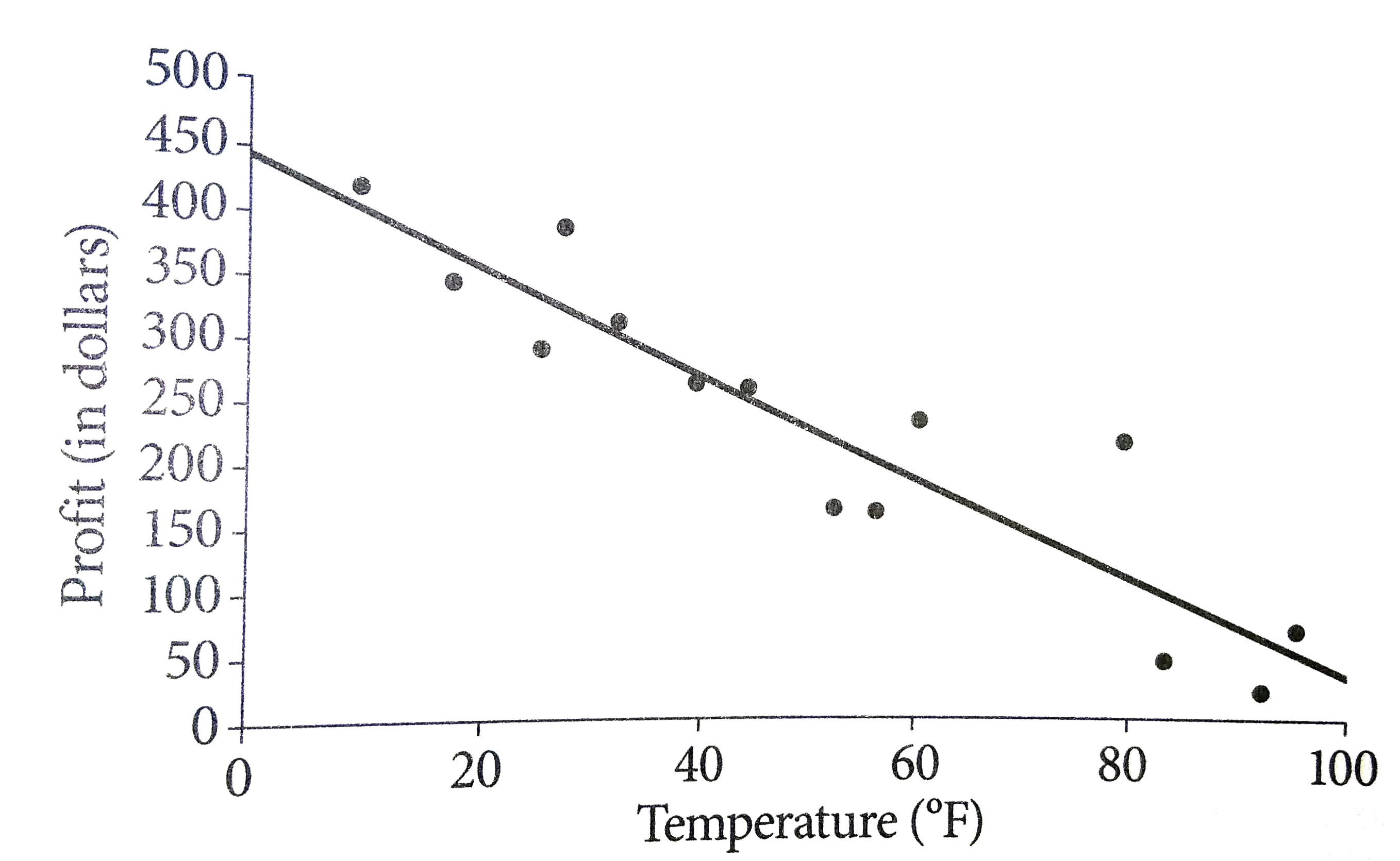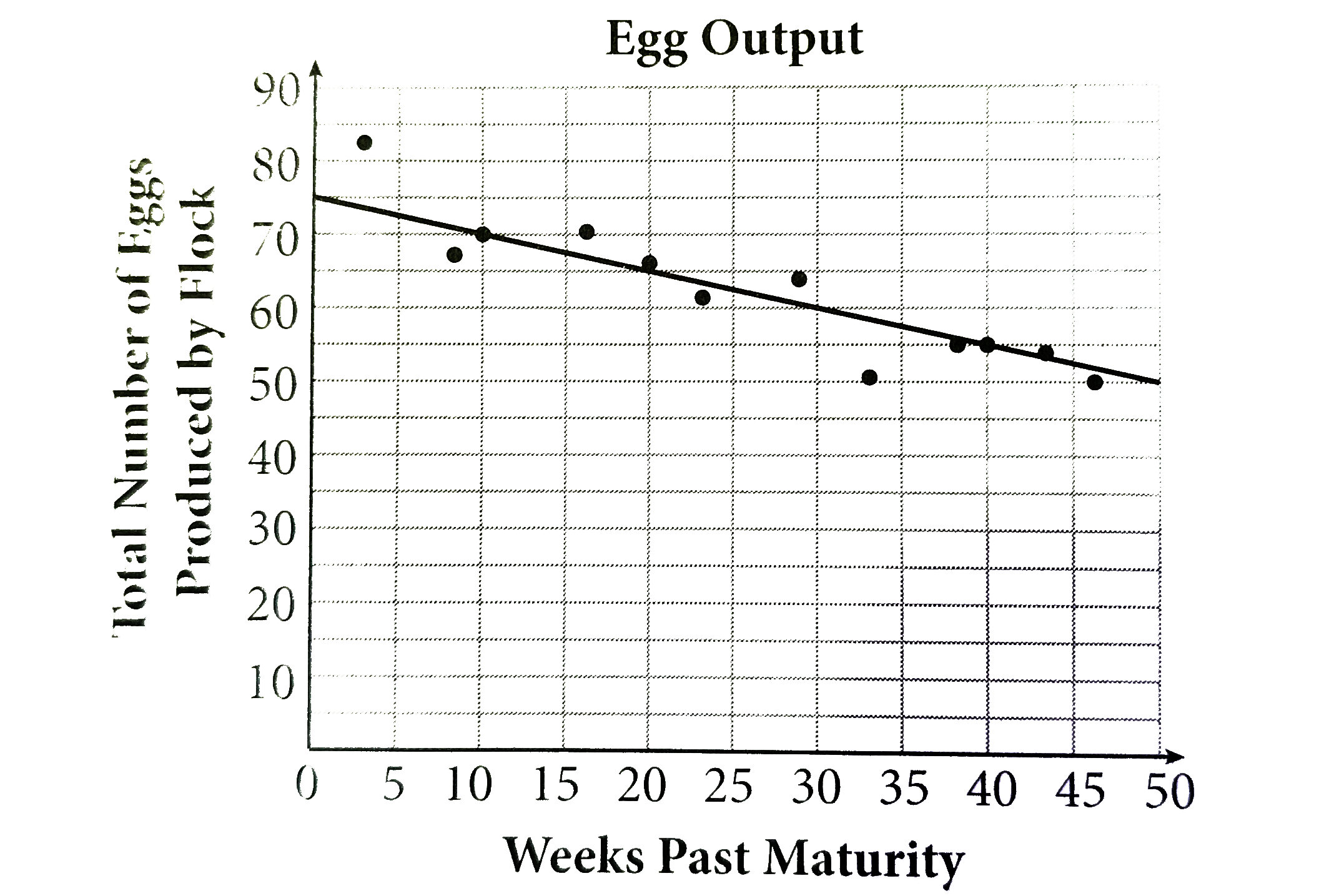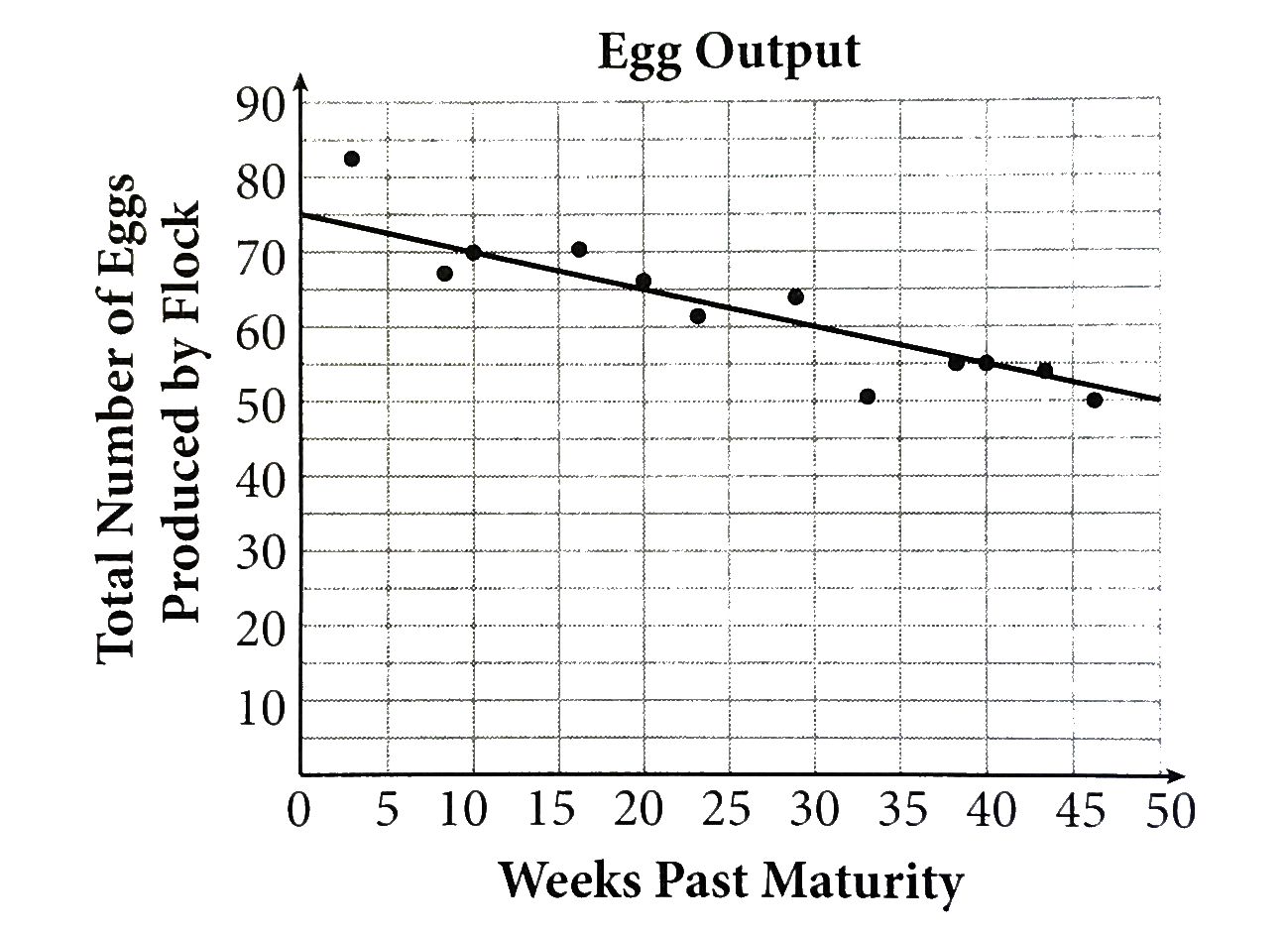
In a given school week the average daily temperature is 20∘F on Monday, Tuesday, and Wednesday and 30∘F on Thursday and Friday. Based on the line of best fit, what was the school store's approximately profit during this school week?
325
650
1475
1700
The correct Answer is:D
Step by step video, text & image solution for In a given school week the average daily temperature is 20^(@)F on Monday, Tuesday, and Wednesday and 30^(@)F on Thursday and Friday. Based on the line of best fit, what was the school store's approximately profit during this school week? by Maths experts to help you in doubts & scoring excellent marks in Class 12 exams.
Updated on:21/07/2023Topper's Solved these Questions
- PROBLEM SETSBOOK - PRINCETONCHAPTER - PROBLEM SETSEXERCISE - PROBLEM SET 9: EXPONENTS, ROOTS, AND EQUATIONS
11 Videos
- PROBLEM SETSBOOK - PRINCETONCHAPTER - PROBLEM SETSEXERCISE - PROBLEM SET 10: LINES, ANGLES, AND COORDINATES
11 Videos
- PROBLEM SETSBOOK - PRINCETONCHAPTER - PROBLEM SETSEXERCISE - PROBLEM SET 7: AVERAGES, RATIOS, PROPORTIONS, AND PROBABILITIES
11 Videos
- PRACTICE TEST 4BOOK - PRINCETONCHAPTER - PRACTICE TEST 4EXERCISE - Math Test-Calculator
38 Videos
- SAT MATH: THE BIG PICTUREBOOK - PRINCETONCHAPTER - SAT MATH: THE BIG PICTUREEXERCISE - Example
4 Videos
Similar Questions
The average of the temperature recorded by the National Climate Centre in New York in a particluar week for Monday, Tuseday, Wednesday and Thusrday was 60∘F. The average for Tuesday , Wednesday, Thursday and Friday in the same week was 55∘ F. If the ratio of the temperature for Monday and Friday was 13:9. What was the temperature on Monday ?
View SolutionThe number of hours Ashu studied on different days of a week are as follows.
Monday: 4 hours
Tuesday: 412 hours
Wednesday : 5 hours
Thursday : 312 hours
Friday : 4 hours
Saturday: 6 hours
Find the average number of hours in a day Ashu studied in that week.
View Solution
Knowledge Check
Most chickens reach maturity and begin laying eggs at around 20 weeks of age. From this point forward, however, as the chicken ages,its eges its egg production decreases. A farmer was given a flock of 100 chickens (all of which were the same age) and asked to meaure daily egg output for the entire flock at random intervals starting at maturity until the chickens were 70 weeks old. The data are recorded in the scatteplot below and the line of best fit has been drawn.

Based on the line of bast fit, what is the predicted number of eggs that will be produced by the flock when it is 33 weeks past maturity ?A33B50C58D64
The scatterplot above shows the daily profit made by a school store from selling sweatshirts and the average daily temperature for several days in the year 2004. The line of best fit is also shown and has equation y=-4.1x+446. Which of the following best explains hoow the number −4.1 in the equation relates to the scatterplot?AFor every 1∘ increase in average daily temperature, the school store's profit fell by approximately $4.10/BFor every 1∘ increase in average daily temperature, the school store's profit fell by approximately $4.10/CFor every 4.1∘ increase in average daily temperature, the school store's profit fell by approximately $4.10/DFor every 4.1∘ increase in average daily temperature, the school store's profit fell by approximately $4.10/The value of a share of stock was $30 on Sunday. The profit of the value in the following week was as follows. The value of the value in the following week was as follows. The value appreciated by $1.2 on Monday . It appreciated by $3.1 on Tuesday. It depreciated by $4 on Wednesday. It appreciated by $2 on Thrusday and it depreciated by $0.2 on Friday. On Friday, the stock market closed for the weekend. By what percentage did the value of the share increase in the five days ?
A3.2%B4%C5.6%D7%
Most chickens reach maturity and begin laying eggs at around 20 weeks of age. From this point forward, however, as the chicken ages,its eges its egg production decreases. A farmer was given a flock of 100 chickens (all of which were the same age) and asked to meaure daily egg output for the entire flock at random intervals starting at maturity until the chickens were 70 weeks old. The data are recorded in the scatteplot below and the line of best fit has been drawn.

How many times did the farmer's data differ by more than 5 eggs from the number of eggs predicted by the line of best fit ?
View SolutionA child running a temperature of 101F is given and antipyrin (i.e. a madicine that lowers fever) which cause an increase in the rate of evaporation of sweat from his body. If the fever is brought down to 98∘F in 20 min., what is the averatge rate of extra evaporation caused, by the drug ? Assume the evaporation mechanism to the only way by which heat is lost. The mass of the child is 30 kg. The specific heat of human body is approximately the same as that of water and latent heat of evaporation of water at that temperature is about 580cal.g−1.
View Solution
A salesperson recorded her sales during a particular 5-day work week, shown in the table above, in order to study her daily sales.
The salesperson wants to increase her averages sales per day by 20% in the following week. Given the information in the chart above, what should her daily sales average be for the following week?
View SolutionThis passage is adapted from a 2018 article summarizing two different proposals for solving problems with maintaining New York City's mass transit system.
The history of the New York City subsaw system, quickly told: the first stations opened in 1904, and over the next century, it expended to 472 stations, more than any other subway system in the world, with 850 miles of track. Operating 24 hours a day seven days a week, with an average weekday ridership of approximately 5.7 million, it is the plant's 7th-busiest rapid transit system. While the system is, on many levels, an amazing chievement, it is also beset by a problem that harms both quality of life and economic activity. Such a large system must inevitably suffer from service interruptions and delays, normal wear and tear combined with the sheer age of the system necessitates regular maintanance. However, there is no consensus as to the best way to accomplish the required repairs. The current maintanance scheme is designed to minimize service interruptions. A subway line in need of repair will be taken out of sevice during a comaratively less busy time, such as nights or weekends, while another line is re-routed to cover as many as possible of the missing line's stops. The main advantage to this approach is that trains are not taken out of service during rush hour, when most subway trips occur, subway service generally remains predictable and commuters are, for the most part, able to use the system to get to their desinations on time.
But critics are quick to point out the disadvantages to this approach. Perhaps most obvious is the confusion caused by trains swithing lines. The labyrinthine system is hard enough to navigate at the best of times. especially for tourists A subway rider on the A terain naturally expects the train to make stops on teh A line. If instead, it is diverted temporatily to the F line, the rader may find herself miles from her intended destination.
While annoying, the confusion arising from route switching is hardly the most serious problem with the current approach to repairs. Because the system runs 24 hours a day, routine maintenance can generally be done only during the temporary closures on nights and weekends. This means that more serious repair and crucial preventative maintenance is often neglected. Problems that could have been fixed or prevented reasonably expeditiously given a slightly longer closure wind up leading to major breakdowns and service interruptions later on.
On rare occasions, such breakdowns have resulted in entire subway lines being shut down for months or even a year. Beginning in 2019, for example the I. Train connecting lower Manhattan to parts of Brooklyn was scheduled to close for as much as 15 months for long overdue service and upgrades. In a city fewar than half of whose households own a car, this can have serious economic impacts Residents of the affected area may face a much longer commute via an alternate subway line if one is available, or, if there is no alternate subway service, they may need to take other, potentially more exppensive, modes of transportation, such as taxis or ferries. Morover, studies indicate that increased stress from the commute to work can lead to lower productivity, and that businesses near the impacted lines may see decreased revenue as potential customers have a harder time getting to them.
One controversial proposal for reducing breakdowns and the resulting transit interruptions is to end the subway's 24-hour service and to shut down for several hours each night. Proponents of this plan argue that this would allow time, on a regular rather than sporadic basis, for more preventative maintanacnce. This, they claim, would ultimately lead to more consistent service, rrather than shutting down entire lines for long periods of a time, there would merely be shorter service outages overnight, when fewer people use the subway system. While this may seem a preferable outcome to the economic consequence of a total shutdown resulting from a breakdown, it has its liabilities as well. While most subway trips may occur during rush hour, not everyone works during the daytime. New yourk is famously known as the "the city that never sleeps." Doctors, nurses, bartenders, police officers, and firefighters are just a few examples of occupations whose workers need transportion at all hours of the day and night. Rather than be subjected to a relatively short period of inconvenience, these workers would find their commutes irrevocably altered. One thing, at least, is clear the city must carefully condider many economic and social factors in designing a subway maintenance plan.
According to the passage, which of the following is true of the New York City subway system ?
View SolutionThis passage is adapted from a 2018 article summarizing two different proposals for solving problems with maintaining New York City's mass transit system.
The history of the New York City subsaw system, quickly told: the first stations opened in 1904, and over the next century, it expended to 472 stations, more than any other subway system in the world, with 850 miles of track. Operating 24 hours a day seven days a week, with an average weekday ridership of approximately 5.7 million, it is the plant's 7th-busiest rapid transit system. While the system is, on many levels, an amazing chievement, it is also beset by a problem that harms both quality of life and economic activity. Such a large system must inevitably suffer from service interruptions and delays, normal wear and tear combined with the sheer age of the system necessitates regular maintanance. However, there is no consensus as to the best way to accomplish the required repairs. The current maintanance scheme is designed to minimize service interruptions. A subway line in need of repair will be taken out of sevice during a comaratively less busy time, such as nights or weekends, while another line is re-routed to cover as many as possible of the missing line's stops. The main advantage to this approach is that trains are not taken out of service during rush hour, when most subway trips occur, subway service generally remains predictable and commuters are, for the most part, able to use the system to get to their desinations on time.
But critics are quick to point out the disadvantages to this approach. Perhaps most obvious is the confusion caused by trains swithing lines. The labyrinthine system is hard enough to navigate at the best of times. especially for tourists A subway rider on the A terain naturally expects the train to make stops on teh A line. If instead, it is diverted temporatily to the F line, the rader may find herself miles from her intended destination.
While annoying, the confusion arising from route switching is hardly the most serious problem with the current approach to repairs. Because the system runs 24 hours a day, routine maintenance can generally be done only during the temporary closures on nights and weekends. This means that more serious repair and crucial preventative maintenance is often neglected. Problems that could have been fixed or prevented reasonably expeditiously given a slightly longer closure wind up leading to major breakdowns and service interruptions later on.
On rare occasions, such breakdowns have resulted in entire subway lines being shut down for months or even a year. Beginning in 2019, for example the I. Train connecting lower Manhattan to parts of Brooklyn was scheduled to close for as much as 15 months for long overdue service and upgrades. In a city fewar than half of whose households own a car, this can have serious economic impacts Residents of the affected area may face a much longer commute via an alternate subway line if one is available, or, if there is no alternate subway service, they may need to take other, potentially more exppensive, modes of transportation, such as taxis or ferries. Morover, studies indicate that increased stress from the commute to work can lead to lower productivity, and that businesses near the impacted lines may see decreased revenue as potential customers have a harder time getting to them.
One controversial proposal for reducing breakdowns and the resulting transit interruptions is to end the subway's 24-hour service and to shut down for several hours each night. Proponents of this plan argue that this would allow time, on a regular rather than sporadic basis, for more preventative maintanacnce. This, they claim, would ultimately lead to more consistent service, rrather than shutting down entire lines for long periods of a time, there would merely be shorter service outages overnight, when fewer people use the subway system. While this may seem a preferable outcome to the economic consequence of a total shutdown resulting from a breakdown, it has its liabilities as well. While most subway trips may occur during rush hour, not everyone works during the daytime. New yourk is famously known as the "the city that never sleeps." Doctors, nurses, bartenders, police officers, and firefighters are just a few examples of occupations whose workers need transportion at all hours of the day and night. Rather than be subjected to a relatively short period of inconvenience, these workers would find their commutes irrevocably altered. One thing, at least, is clear the city must carefully condider many economic and social factors in designing a subway maintenance plan.
Which choice provides the best evidence for the answer to the previous queston ?
View Solution
